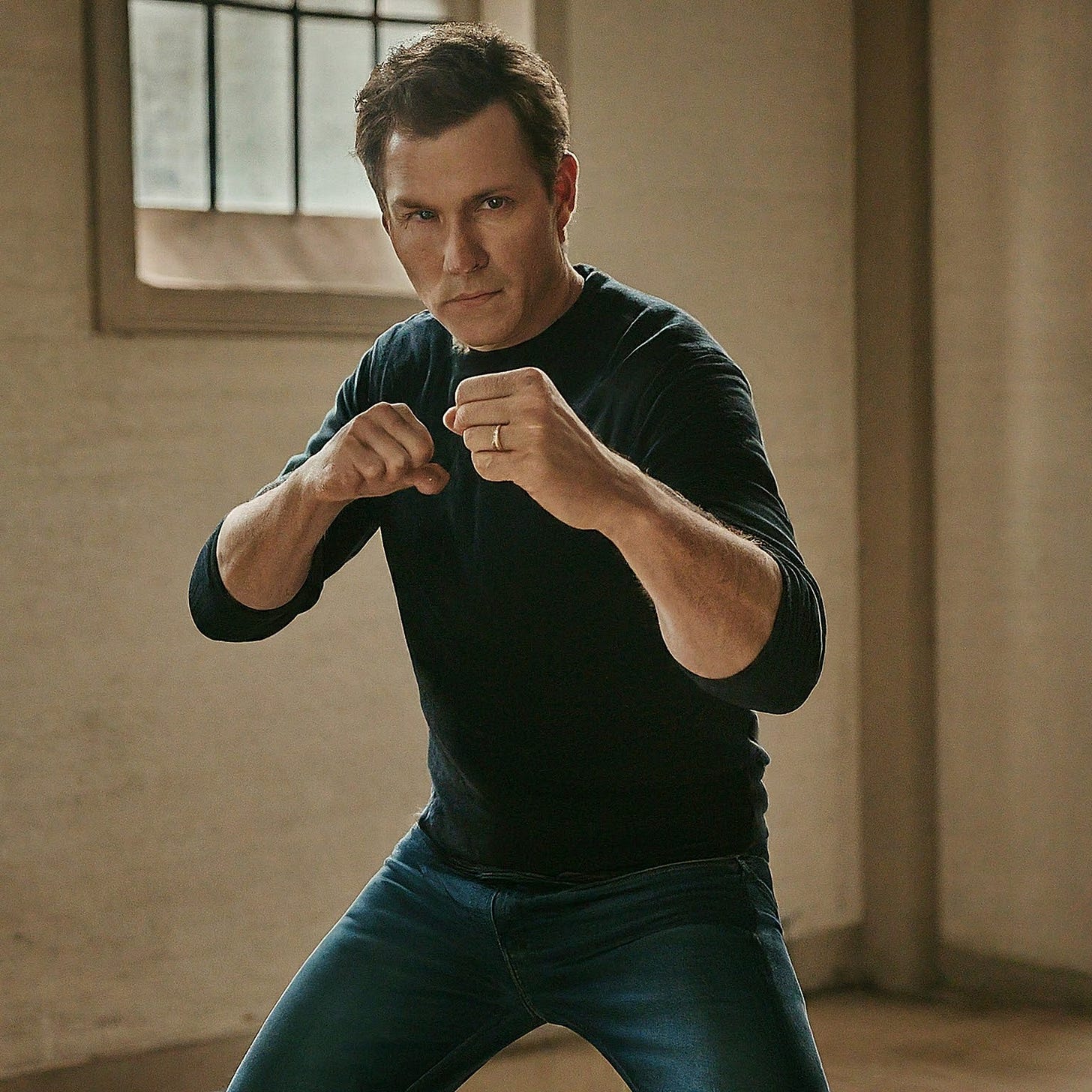Introduction
This is part two of a series exploring the differences between the bladed and squared stances. If you have not read the previous part, I would recommend going back and reading it as it can provide additional context.
The Squared Stance
While the bladed stance allows for stronger linear movement and attacks, the squared stance allows for stronger circular movement and attacks. The wider horizontal base allows for superior circular footwork, strengthening one’s ability to effectively mitigate the opponent’s tools in close range by moving to the outside of the opponent. The bladed stance tends towards a hit-and-run style due to its weakness in close quarters. By contrast, the squared stance thrives in close quarters due to its superior circular movement. By extension, the squared stance has weaker linear movement, which weakens its potential at long-range. Hence, the squared stance tends towards one of two styles. First, a style based on constant forward pressure and circling to the opponent’s outside, which is especially important when the opponent is utilizing a bladed stance effectively. Second, a style based on defensive range management and utilizing angles when the opponent becomes too aggressive. This latter approach tends to see greater utilization in matches where both fighters are utilizing squared stances.
While the bladed stance allows for stronger linear movement and attacks, the squared stance allows for stronger circular movement and attacks.
The greater effectiveness of circular footwork translates into striking as well. From the bladed stance, rear leg roundhouse kicks are often too telegraphed to be effective. By contrast, the squared stance has powerful rear leg roundhouse kicks as the foot is closer to the target and the wider horizontal base allows for greater stability. Similarly, the fadeaway hook (in which one pivots out to their opponent’s side while throwing a hook punch) is very difficult to perform from a bladed stance due to already facing sideways. However, in a squared stance, it is much easier. The wider horizontal base allows one to pull their foot backward into a more bladed stance allowing one to move to their opponent’s side more effectively. The capacity to create angles and reduce the effectiveness of the opponent’s tools makes this stance quite effective in a close-range exchange.
On the same note, the decreased distance between the lead and rear hand, due to the increased vertical closeness of the legs, allows one to more effectively utilize both hands in punching combinations. When engaging an opponent at close-range, it is important to be able to throw effective and varied combinations as a means of controlling the pace and momentum of the fight. The bladed stance tends to force the individual to rely heavily on the lead hand, playing into its hit-and-run style. By contrast, the squared stance allows for greater utilization of both hands enabling more attacks from the rear and a greater variety of combinations, which can be devastating, especially when combined with speed and heavy hands (powerful punches).
…the squared stance allows for greater utilization of both hands enabling more attacks from the rear and a greater variety of combinations
However, this greater variety of combinations and rear-hand striking potential comes at the cost of striking defense. Given the more front-facing nature of the stance, the fighter is more exposed to strikes targeted at vital areas. As such, utilizing a more active and aggressive defense becomes essential to utilize this stance effectively.
…utilizing a more active and aggressive defense becomes essential to utilize this stance effectively.
In return for greater striking vulnerability, the grappling potential of the squared stance is superior to that of the bladed stance. Clinching, takedowns, and throws are largely awkward from a bladed stance but are very effective from a squared stance due to the wider horizontal base and the more front-facing nature of the stance. The same is true for takedown defense. Takedown defense from the bladed stance is awkward and often poor (e.g., sprawling from a bladed stance). By contrast, takedown defense from the squared stance is substantially easier and more effective due to the wider horizontal base. Therefore, grapplers tend to utilize a more squared stance.
…the grappling potential of the squared stance is superior to that of the bladed stance.
Stances are Non-Binary
When comparing these stances, it becomes evident that each stance has its benefits and drawbacks. However, one should not fall into the trap of thinking of these stances as binary. While it is useful for analytical purposes to describe these stances as binary, it is not useful to think or act as if this is the case. Many stances fall between the extremes of an entirely bladed or an entirely squared stance (see below).
One commonly taught mixed martial arts stance takes aspects of both a bladed and squared stance. Similarly, some fighters utilize a bladed stance with the feet not entirely parallel or a narrow squared stance with the back foot turned ninety degrees outward. In short, stances exist on a spectrum.
In short, stances exist on a spectrum.
It Depends on your Fighting Style
The effectiveness of a particular stance is going to be largely dependent on one’s preferred fighting style. In practice, many individuals utilize the stance they are most comfortable with as they tend to lack the diversity of experience to determine which stance would be most effective for their preferred fighting style. My inherent bias is toward a more squared stance as that is what I have utilized for most of my martial arts training. However, I have recently begun utilizing a bladed stance, and I have come to appreciate its usefulness. As such, I have spent my time pondering the nature of each stance, which eventually led to this article.
The effectiveness of a particular stance is going to be largely dependent on one’s preferred fighting style.
My current position on stances is twofold. First, I believe the squared stance is more effective for self-defense. In self-defense, one must focus on defending oneself at close range because, at a longer range, it is often optimal to run away instead of fighting. The range the bladed stance tends to fight best at is generally far enough to allow one to run away from the encounter. While not every encounter can be escaped from, in the majority of instances, effective self-defense consists of awareness, preparation, and escape (not combat). When combat is engaged in, it is done so as a last resort. Also, there are key weaknesses of the bladed stance that are unacceptable for the majority of self-defense encounters. The bladed stance’s weakness with grappling and being takedown represents a significant threat in the vast majority of self-defense situations as fighting on the ground against multiple assailants and/or while weapons are involved is a poor strategy. Hence, I believe that adopting at least some aspects of the squared stance is more effective for self-defense.
…the squared stance is more effective for self-defense.
Second, I have begun utilizing a more bladed stance. I call my current stance a linear stance. A linear stance involves the feet being horizontally shoulder-width apart and vertically wider than shoulder-width. The feet should vertically be far enough apart, such that if one were to kneel, it would not touch the back of the front foot. This width allows for greater stability and ease of movement. The front foot points forward, while the back foot points at a forty-five-degree angle. In terms of hand positioning, I prefer to keep my rear hand high to protect my face, while keeping my lead hand slightly lower and further from my face. This stance represents a compromise between the squared and bladed stance. It takes some of the benefits and drawbacks of both stances. It has thus far worked for me during practice, but I am still in the early stages of testing it. Maybe at a future point, I will write an article providing an update on my progress with this stance.
Next Time
This is the final part of a two-part series exploring both stances. Please subscribe to stay up-to-date for when the next article drops. If you have a friend, family member, or acquaintance who would enjoy this content, please share. If you would like to, leave a comment. I would love to hear from you!







